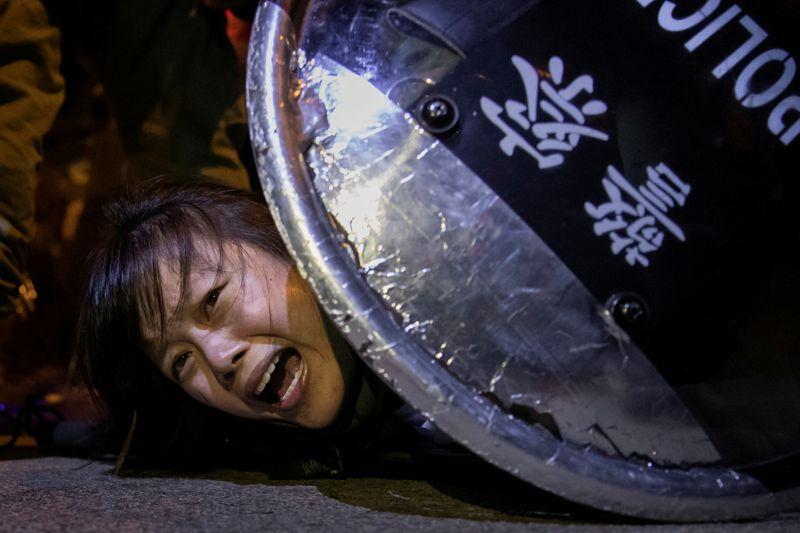By Reuters Communications
On Monday, Reuters was awarded a 2020 Pulitzer Prize for Breaking News Photography for a series of photographs on the protests in Hong Kong last year.
Here, Reuters photojournalists share the stories of how they captured their Pulitzer Prize-winning photos:
TYRONE SIU (photo above)
The emotions shown on her face were so strong and striking that it left a lasting memory. But it was only one day of many days, one face of many young faces being detained by the police in this manner throughout the months-long protest.
ADNAN ABIDI
A couple of days back, the view of the swimming pool was amazing. It used to be a practice ground for anti-government protestors. Most of them were protesting for the first time so they used to come there and practice for throwing Molotov cocktails and use bows and arrows to practice their aim.
AMAR AWAD
During my assignment to cover the crisis in Hong Kong, we captured a lot of violence in the streets. But I looked for something different than clashes to tell what was happening. Capturing this woman in a moment while she was looking at violence with a concerned look was one way to tell this story differently.
ANUSHREE FADNAVIS
While being chased by police, the anti-government protestors took an alternate route to escape the Hong Kong International airport and on their way, they started blocking roads using bricks and barricades. I saw so many people trying to get to the airport through the blockades with their luggage. I wanted to tell a story in a picture to show the hardships faced by travellers while on the way to the airport and the contrast of the things happening amidst the unrest.
WILLY KURNIAWAN
The protesters entered a shopping area in Tsuen Wan after big clashes and police were trying to chase them. They moved from place to place quickly and ran very fast. I followed them since this was the only route I knew for escaping in case something dangerous happened around me. That was my first time in Hong Kong and all the corners were unfamiliar for me.
LEAH MILLIS
This photograph was taken during a pretty quiet protest in Kowloon Bay. A few hundred people met up at a metro stop in the evening. There were children and elderly people. Compared to many of the previous protests, this one was quite small. A line of people linked hands to show solidarity and peaceful support for the movement and to protest against police brutality. I was stopped in my tracks by this man holding hands with the people beside him while a small child hung in front of him in a child harness with a little mask on, too.
ATHIT PERAWONGMETHA
I walked up to the top of Lion Rock Mountain alongside protesters who queued from the bottom to the top of this mountain. It took 6 hours, and was worth it for the best picture to show their spirit to ‘Free Hong Kong.’
THOMAS PETER
The raid on the mall lasted only a few minutes. I never stood still for any amount of time, shooting mostly while I was on the move. On the way out, someone threw a petrol bomb onto the Christmas tree that rose from the ground floor all the way to the ceiling in the spacious lobby. Then another petrol-filled bottle flew, and another. Within minutes the tree was engulfed in flames.
KAI PFAFFENBACH
My ‘half-portrait’ of Carrie Lam seems to be the least action-frame in the series, but shows a key figure in the protest. Her weekly press conference was scheduled for 9am and we had a rough tear-gas the night before, but I volunteered to wake up early to go. I decided to go for something different and outside of the photo-school books: very tight, half face-portrait and I assume it worked. It shows the fragile side of Lam, who usually appears to be super tough.
JORGE SILVA
There was a very tense encounter inside a subway station. They shouted, pushed very close to fight. Every time pro-China supporters and anti-government protesters faced each other, they were very close and the atmosphere was charged with a violent tension. I’m so proud of the strong commitment from all my colleagues covering this the story and raising awareness in every frame.
SUSANA VERA
As Hong Kong police were firing tear gas on anti-government protesters, riot police appeared in the mist and dragged dozens of them to the ground to detain them. I got as close as I could to show the intensity of the moment amid the chaos before police pushed me back.
[Reuters PR Blog Post]
Media contact:
Heather Carpenter
heather.carpenter @ thomsonreuters.com
